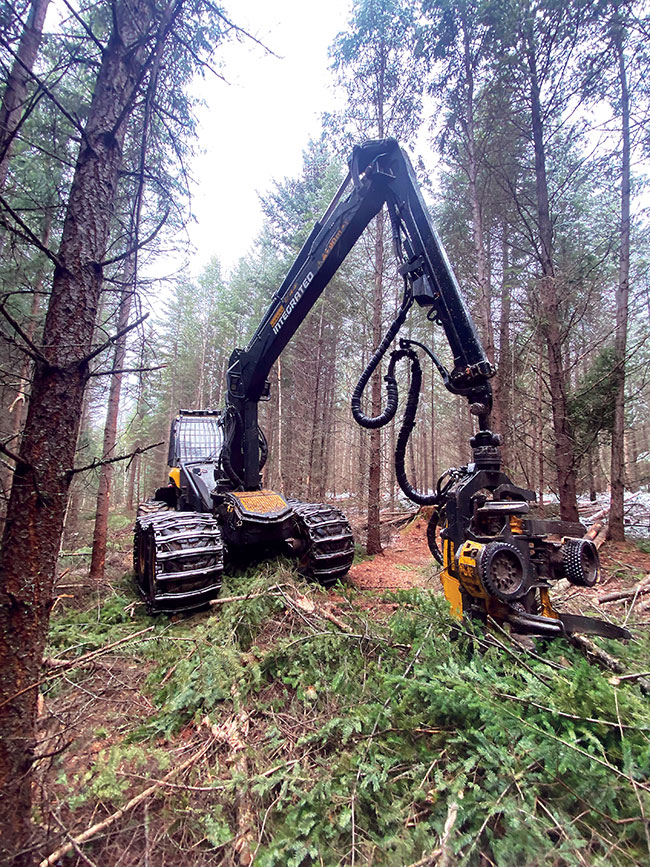
Features
Harvesting
Revolutionizing B.C. forests
Focusing on sustainable practices for fire-resilient communities
February 22, 2024 By Quentin Stefani and Sig Kemmler
 Forests are not just static timber reserves; they are dynamic ecosystems that require careful management to maintain their health and biodiversity.
Forests are not just static timber reserves; they are dynamic ecosystems that require careful management to maintain their health and biodiversity. In the beautiful expanses of British Columbia’s 54 million hectares of forests, a new era of forestry is emerging. As the importance of our forests becomes even more evident, the industry is at the forefront of this revolution, employing innovative techniques and equipment to promote commercial thinning and fire hazard abatement. Let’s look at the benefits of thinning from below as opposed to the traditional thinning from above, with focus on gaining social license and of communities.
Forests are not just static timber reserves; they are dynamic ecosystems that require careful management to maintain their health and biodiversity. We just experienced the largest forest fire season in modern times. The importance for fire-proofing every community across Canada cannot be overstated. We have the option of spending billions to fight or invest millions in prevention.
The forest industry faces the challenge of balancing economic viability with ecological stewardship and community well-being. Our commitment extends beyond the forests to the communities that surround them, ensuring their voices are heard and their surrounding forests endure.
Our approach is powered by state-of-the-art equipment including wheeled harvesters, forwarders, and custom-built mini feller bunchers. These complex machines are more efficient and designed to minimize environmental and local impact: quiet, low ground pressure, extremely fuel efficient. This is not reinventing the wheel – we are applying systems, tools and technology that has been proven for decades in Scandinavia and the rest of Europe. They allow for precise cuts, reducing unnecessary damage and promoting quicker forest recovery. There is no need for any large clear cuts or openings.
Thinning from below involves removing smaller, suppressed trees and underbrush. They are less commercially valuable, but may contribute to fire fuel loading. We leave the large trees. This has several advantages over the traditional thinning from above where larger, dominant trees are removed:
- Enhanced forest health: By reducing competition for limited resources, we help promote a more resilient forest.
- Fire hazard reduction: Reducing dense undergrowth significantly mitigates risk and intensity of forest fires.
- Biodiversity preservation: preserves the canopy and the habitat it provides, maintaining the forest’s biodiversity.
- Sustainable yield: Focusing on smaller trees ensures improved growth and productivity of the forest, aligning with long-term conservation goals.
Gaining social license goes beyond mere legal permissions – it’s about earning the trust and support of the people in communities surrounded by forests. Professional foresters must engage with local residents, Indigenous groups and stakeholders to understand their concerns and incorporate their insights into planned forestry practices. The threat of wildfires is a pressing concern, and thinning practices could play a crucial role in protecting adjacent communities by reducing fuel loads, crown closure and creating buffer zones, while protecting water resources. Anytime a large forest fire is prevented, a significant immediate carbon and particulate release has been stopped.
Canada has 12 per cent of the world’s land-based carbon reserves. In 2023, 18.4 million hectares of Canadian forests were burned. Canada is now ranked as the 11th highest in the world for GHG emissions. It is important to note that the international agreement for calculating GHG emissions includes only human sources.
Total carbon emissions from wildfires across Canada totaled 290 megatonnes between Jan. 1 and July 31, 2023, showing that the prevention of extreme forest fires is now more important than ever – we can get the sense of the impact our forest practises could have on future actual GHG emissions. These figures are hard to imagine – one megatonne equals one billion kilograms. For comparison, the CN Tower weighs 0.1179 megatonnes.
Fire hazard abatement can lead to a more fire resilient, sustainable forest, and more prosperous community. The public, policy makers and politicians need to be aware of the options that exist. The path we choose now will define the future of our forests and communities.
Quentin Stefani, TFT, and Sig Kemmler, FT, are managing partners for the Integrated Operations Group, based in Campbell River, B.C.
Print this page